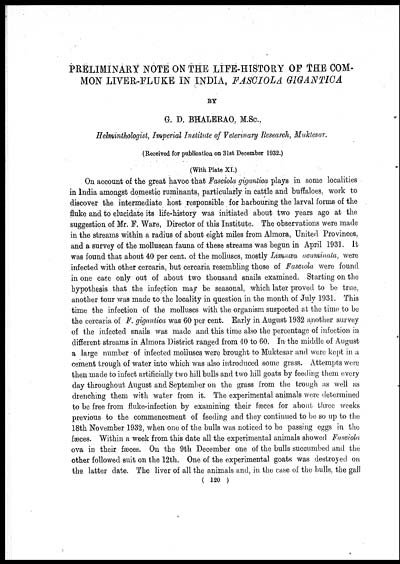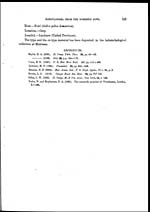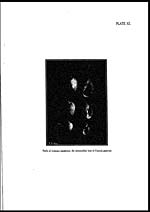Medicine - Veterinary > Veterinary colleges and laboratories > Indian journal of veterinary science and animal husbandry > Volume 3, 1933 > Original articles > Preliminary note on the life-history of the common liver-fluke in India. Fasciola gigantica
(162) Page 120
Download files
Individual page:
Thumbnail gallery: Grid view | List view

PRELIMINARY NOTE ON THE LIFE-HISTORY OF THE COM-
MON LIVER-FLUKE IN INDIA, FASCIOLA GIGANTICA
BY
G. D. BHALERAO, M.Sc.,
Helminthologist, Imperial Institute of Veterinary Research, Muktesar.
(Received for publication on 31st December 1932.)
(With Plate XI.)
On account of the great havoc that Fasciola gigantica plays in some localities
in India amongst domestic ruminants, particularly in cattle and buffaloes, work to
discover the intermediate host responsible for harbouring the larval forms of the
fluke and to elucidate its life-history was initiated about two years ago at the
suggestion of Mr. F. Ware, Director of this Institute. The observations were made
in the streams within a radius of about eight miles from Almora, United Provinces,
and a survey of the molluscan fauna of these streams was begun in April 1931. It
was found that about 40 per cent. of the molluscs, mostly Limnæa acuminata, were
infected with other cercaria, but cercaria resembling those of Fasciola were found
in one case only out of about two thousand snails examined. Starting on the
hypothesis that the infection may be seasonal, which later proved to be. true,
another tour was made to the locality in question in the month of July 1931. This
time the infection of the molluscs with the organism suspected at the time to be
the cercaria of F. gigantica was 60 per cent. Early in August 1932 another survey
of the infected snails was made and this time also the percentage of infection in
different streams in Almora District ranged from 40 to 60. In the middle of August
a large number of infected molluscs were brought to Muktesar and were kept in a
cement trough of water into which was also introduced some grass. Attempts were
then made to infect artificially two hill bulls and two hill goats by feeding them every
day throughout August and September on the grass from the trough as well as
drenching them with water from it. The experimental animals were determined
to be free from fluke-infection by examining their fæces for about three weeks
previous to the commencement of feeding and they continued to be so up to the
18th November 1932, when one of the bulls was noticed to be passing eggs in the
fæces. Within a week from this date all the experimental animals showed Fasciola
ova in their fæces. On the 9th December one of the bulls succumbed and the
other followed suit on the 12th. One of the experimental goats was destroyed on
the latter date. The liver of all the animals and, in the case of the bulls, the gall
(120)
Set display mode to: Large image | Zoom image | Transcription
Images and transcriptions on this page, including medium image downloads, may be used under the Creative Commons Attribution 4.0 International Licence unless otherwise stated. ![]()
| Permanent URL | https://digital.nls.uk/75229908 |
|---|
| Description | Covers articles from 1933. |
|---|




